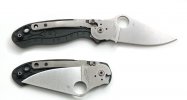Triad lock, not just because it’s strong, but it’s also simple. It doesn’t require full or partial liners to function(unlike axis-style lock), and liners only make it stronger.
It also does not depend on a specific handle material to make it work, unlike framelock/liner lock that requires steel or titanium liner to provide the structural strength. So triad lock works well with any handle material, g10, aluminum, plastic, titanium etc.
Triad is also ambidextrous, and have strong self-close without relying on detent ball which means they have consistent detent unlike most liner and frame lock knives.
It also does not depend on a specific handle material to make it work, unlike framelock/liner lock that requires steel or titanium liner to provide the structural strength. So triad lock works well with any handle material, g10, aluminum, plastic, titanium etc.
Triad is also ambidextrous, and have strong self-close without relying on detent ball which means they have consistent detent unlike most liner and frame lock knives.




